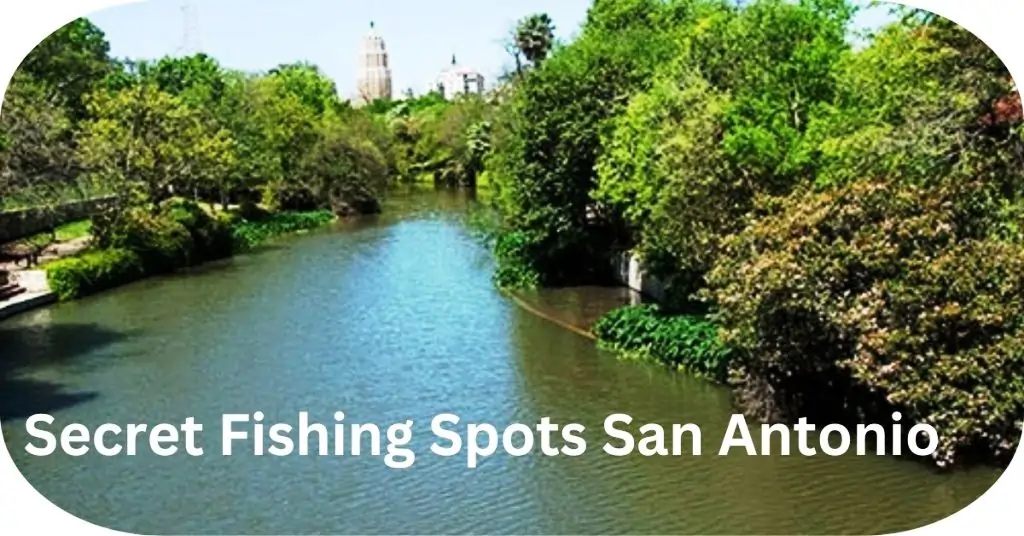Welcome to our ultimate guide on “Secret Fishing Spots San Antonio: The Best Mentor of 2024.” In this post, we’ll reveal hidden gems perfect for anglers seeking new adventures in San Antonio’s diverse waters. Discovering these secret spots not only enhances your fishing experience but also connects you with nature in a unique way. We’ll introduce you to the concept of a fishing mentor, an invaluable guide who can elevate your skills, share insider tips, and help you make the most of your fishing trips. Whether you’re a seasoned angler or a beginner, this blog will be your go-to resource for uncovering San Antonio’s best-kept fishing secrets.
Why San Antonio is a Fishing Haven
Natural Beauty and Diverse Aquatic Life
San Antonio is a paradise for anglers, offering a stunning array of natural beauty and rich aquatic life. The city is blessed with numerous lakes, rivers, and creeks, each teeming with a variety of fish species. From the serene waters of Medina River to the bustling Calaveras Lake, the diverse environments provide ideal habitats for fish such as largemouth bass, catfish, and sunfish. The scenic landscapes surrounding these waters enhance the fishing experience, making it not just a sport but a true immersion in nature’s splendor.
Local Fishing Culture and Community
San Antonio boasts a vibrant fishing culture deeply rooted in tradition and community spirit. Local anglers are known for their welcoming nature and willingness to share knowledge and experiences. Numerous fishing clubs and organizations foster a strong sense of camaraderie, offering opportunities for both seasoned anglers and beginners to connect, learn, and grow. Regular fishing tournaments and events further enrich the community, providing a platform for friendly competition and skill enhancement. This thriving culture makes San Antonio a supportive and dynamic place for fishing enthusiasts.
Seasonal Highlights and Ideal Times for Fishing
San Antonio’s fishing opportunities are abundant year-round, with each season bringing its own unique highlights:
- Spring: This season is particularly favorable as fish become more active and move to shallower waters to spawn. It’s an excellent time for catching largemouth bass and sunfish.
- Summer: Despite the heat, early mornings and late evenings offer productive fishing windows. Anglers can target species like catfish and crappie during these cooler periods.
- Fall: As temperatures cool, fish feed more aggressively in preparation for winter, making it an ideal time for catching bass and catfish. The fall foliage also adds a picturesque backdrop to your fishing adventures.
- Winter: Fish move to deeper, warmer waters, and species like trout are more prevalent. This season is perfect for anglers who enjoy a quieter, more tranquil fishing experience.
The Role of a Fishing Mentor
Definition and Importance of a Fishing Mentor
A fishing mentor is an experienced angler who provides guidance, support, and knowledge to fellow fishing enthusiasts, particularly those who are new to the sport. This role is crucial in fostering a deeper understanding of fishing techniques, local fishing spots, and sustainable practices. A mentor’s expertise helps bridge the gap between novice and seasoned anglers, ensuring that newcomers can enjoy and excel in their fishing endeavors.
How a Mentor Enhances the Fishing Experience
A fishing mentor significantly enhances the fishing experience by offering personalized advice and hands-on instruction. They can teach essential skills such as bait selection, casting techniques, and fish handling. By sharing their knowledge of local water bodies and fish behavior, mentors help anglers make informed decisions, increasing their chances of a successful catch. Additionally, mentors provide encouragement and support, making the learning process enjoyable and less daunting.
Benefits of Guided Fishing Trips and Local Expertise
- Access to Prime Fishing Spots: Guided trips with a mentor often include visits to lesser-known, productive fishing locations that might not be easily discovered by newcomers. This insider knowledge ensures a more rewarding fishing experience.
- Skill Development: Under the guidance of a mentor, anglers can quickly improve their techniques, learning advanced methods and tips that would take much longer to acquire independently.
- Safety and Confidence: Fishing mentors educate anglers on safety practices, from proper equipment use to understanding water conditions. This knowledge boosts confidence and ensures a safer fishing experience.
- Sustainable Practices: Mentors emphasize the importance of eco-friendly fishing, teaching techniques like catch and release, and proper waste disposal. This guidance helps preserve fish populations and protect the environment.
- Local Insights and Stories: Mentors often share fascinating local stories and traditions related to fishing, enriching the overall experience and deepening the angler’s connection to the local culture and ecosystem.
Top Secret Fishing Spots San Antonio
Spot 1: Salado Creek

- Description and Unique Features:
- Salado Creek winds through San Antonio, offering a peaceful fishing environment surrounded by lush greenery and natural beauty. The creek’s calm waters and abundant shade make it a perfect spot for a relaxing fishing day.
- Best Times and Techniques for Fishing:
- Best Times: Early morning and late afternoon are ideal for fishing at Salado Creek.
- Techniques: Use light tackle with live bait such as worms or minnows. Casting near overhanging branches and submerged structures can yield good results.
Spot 2: Leon Creek

- Description and Unique Features:
- Leon Creek is a hidden gem known for its clear waters and diverse fish population. The creek flows through various parks, providing easy access and a variety of fishing spots.
- Recommended Bait and Fishing Tips:
- Bait: Crickets, small jigs, and artificial lures work well in Leon Creek.
- Fishing Tips: Focus on areas with slow-moving water and deeper pools. Early mornings and overcast days tend to be the most productive times.
Spot 3: Woodlawn Lake

- Description and Unique Features:
- Woodlawn Lake is a popular urban fishing destination featuring a large, scenic lake with easy access and well-maintained facilities, making it a favorite among local anglers.
- Species Commonly Found and Fishing Strategies:
- Species: Largemouth bass, catfish, and bluegill are commonly found here.
- Strategies: Use crankbaits or soft plastics for bass, while stink bait or chicken liver is effective for catfish. Fishing near the piers and along the shoreline vegetation is recommended.
Spot 4: Medina River Natural Area

- Description and Unique Features:
The Medina River Natural Area offers a serene fishing experience with its crystal-clear waters and abundant wildlife. The river’s gentle flow and picturesque surroundings provide a tranquil setting for anglers. - Tips for Accessing and Fishing in This Area:
- Access Tips: Park at the designated areas and follow the well-marked trails to the riverbanks.
- Fishing Tips: Use medium to light tackle with live bait such as worms or small crayfish. Focus on deeper pools and areas with slow currents for the best results.
Spot 5: Calaveras Lake

- Description and Unique Features:
Calaveras Lake is renowned for its large size and warm waters, which attract a variety of fish species. The lake’s well-developed facilities and ample fishing spots make it a top choice for both shore and boat fishing. - Effective Techniques and Common Catches:
- Techniques: Use trolling or drifting methods with live shad or cut bait to target larger fish. Early morning and late evening are prime times for fishing.
- Common Catches: Red drum, hybrid striped bass, and channel catfish are frequently caught here.
Expert Tips from the Best Fishing Mentor of 2024
Insider Tips on Selecting the Right Gear and Bait
- Selecting the Right Gear:
- Rods and Reels: Choose a rod and reel combo based on your target species and fishing environment. For larger fish like bass or red drum, opt for medium to heavy rods with sturdy reels. For smaller species like bluegill or crappie, lighter rods provide better sensitivity and control.
- Line Selection: Use monofilament lines for their versatility and ease of use, or braid for added strength and sensitivity in challenging conditions. Fluorocarbon lines are excellent for clear water due to their low visibility.
- Hooks and Sinkers: Match hook sizes to your bait and target species. Use circle hooks for catch-and-release fishing and split shot or bullet sinkers to adjust your bait’s depth effectively.
- Choosing the Right Bait:
- Live Bait: Live shrimp, worms, and minnows are versatile and attract a wide range of fish. Use live shad or crayfish for targeting larger predatory fish.
- Artificial Lures: Select lures based on water conditions and fish behavior. Crankbaits and spinnerbaits are effective in murky waters, while soft plastics and jigs work well in clear waters.
Advanced Fishing Techniques and Tricks
- Technique 1: Jigging:
- Description: Jigging involves vertically lifting and dropping your bait to mimic the movement of injured prey, enticing predatory fish.
- Tips: Use brightly colored jigs in deeper waters and natural colors in clear, shallow areas. Vary your jigging speed to match fish activity levels.
- Technique 2: Topwater Fishing:
- Description: Topwater fishing uses lures that float on the surface, creating splashes and movements that attract fish.
- Tips: Employ a stop-and-go retrieve to mimic struggling prey. Early mornings and late evenings are ideal times for topwater action.
- Technique 3: Drifting and Trolling:
- Description: Drifting involves allowing your boat to move with the current while your bait drifts naturally. Trolling uses a slow-moving boat to pull lures or bait through the water.
- Tips: Use planer boards to spread your lines and cover more water. Adjust trolling speed to match the activity level of the fish.
Advice on Reading Water and Spotting Fish
- Reading Water:
- Current and Flow: Look for areas where water currents change direction or speed, such as points, bends, or drop-offs. Fish often congregate in these areas to ambush prey.
- Water Clarity: In clear water, use natural-colored baits and approach fishing spots quietly. In murky water, opt for bright or noisy lures to attract fish.
- Temperature and Oxygen Levels: Fish are more active in areas with optimal temperatures and higher oxygen levels. Look for cooler, oxygen-rich spots in the summer and warmer areas in the winter.
- Spotting Fish:
- Surface Activity: Watch for signs of fish activity on the water’s surface, such as jumping fish or ripples, which indicate feeding fish.
- Structure and Cover: Identify structures like submerged logs, rocks, and vegetation where fish often hide. Use polarized sunglasses to reduce glare and enhance underwater visibility.
- Bird Activity: Pay attention to birds diving into the water, as they often indicate the presence of baitfish, which attract larger predatory fish.
Gear and Equipment Recommendations for San Antonio Fishing
Essential Gear for San Antonio Fishing
- Fishing Rods and Reels: Select rods and reels that match the local fish species and fishing environments. For San Antonio, a mix of medium to heavy rods for lakes and lighter rods for creeks and rivers is ideal.
- Tackle Box: A well-organized tackle box with compartments for hooks, sinkers, lures, and other accessories is essential for efficient fishing.
- Fishing Line: Carry a variety of lines, including monofilament for general use, braid for strength, and fluorocarbon for low visibility in clear waters.
- Bait and Lures: Stock up on live bait such as worms, minnows, and shrimp, as well as artificial lures like crankbaits, soft plastics, and jigs tailored to local fish species.
- Fishing Net: A durable net for landing fish safely, particularly useful for larger catches.
- Polarized Sunglasses: Essential for reducing glare and improving visibility below the water’s surface, helping to spot fish and underwater structures.
- Sun Protection: Include sunscreen, hats, and long-sleeve clothing to protect against sun exposure.
- Cooler: A cooler with ice packs to keep your catch fresh and store drinks and snacks.
- First Aid Kit: A comprehensive first aid kit to handle minor injuries and emergencies.
Recommended Rods, Reels, and Tackle
- Rods:
- Medium to Heavy Rods: Ideal for targeting larger species like bass and catfish in lakes. Brands like Ugly Stik or St. Croix offer durable and reliable options.
- Light Rods: Perfect for smaller species and more delicate fishing in creeks and rivers. Consider brands like Shimano or Daiwa for high-quality light rods.
- Reels:
- Spinning Reels: Versatile and easy to use, suitable for a wide range of fishing conditions. Look for models from Penn or Abu Garcia.
- Baitcasting Reels: Provide greater control and power, ideal for targeting larger fish. Brands like Lew’s and Shimano offer excellent baitcasting reels.
- Tackle:
- Hooks: Carry a variety of hook sizes, including circle hooks for catch-and-release fishing and treble hooks for lures.
- Sinkers: Include split shot, bullet, and egg sinkers to adapt to different fishing conditions and bait presentations.
- Lures: Stock up on crankbaits for depth, spinnerbaits for flash and vibration, and soft plastics for versatility.
Tips on Packing and Preparing for a Fishing Trip
- Organize Your Gear: Arrange your tackle box and gear bag the night before, ensuring all essentials are in place and easily accessible.
- Check Weather and Water Conditions: Review the weather forecast and water conditions to prepare appropriately and adjust your gear selection if needed.
- Pack Adequate Food and Water: Bring enough food and water to stay hydrated and energized throughout the day, especially in warmer weather.
- Prepare for Emergencies: Ensure your first aid kit is stocked, and bring a charged phone with emergency contacts saved.
- Dress Appropriately: Wear moisture-wicking and UV-protective clothing, and layer up if fishing early morning or late evening to adjust to changing temperatures.
- Double-Check Your License and Regulations: Verify that your fishing license is valid and review local fishing regulations to comply with size, catch limits, and permitted fishing methods.
Eco-Friendly Fishing Practices
Importance of Sustainable Fishing
Sustainable fishing is crucial for maintaining healthy fish populations and preserving aquatic ecosystems for future generations. By adopting eco-friendly fishing practices, anglers can minimize their environmental impact, ensure the longevity of fish species, and protect the delicate balance of marine and freshwater habitats. Sustainable fishing not only supports biodiversity but also ensures that fishing remains a viable and enjoyable activity for years to come.
Tips for Practicing Catch and Release
- Use Barbless Hooks: Barbless hooks cause less damage to fish, making it easier to release them with minimal injury. If barbless hooks are not available, you can flatten the barbs on regular hooks with pliers.
- Handle Fish Gently: Wet your hands before handling fish to protect their slime coat, which is vital for their health. Avoid squeezing or holding fish by the gills.
- Minimize Air Exposure: Keep the fish in the water as much as possible. If you need to lift it out, do so briefly and return it to the water quickly to reduce stress.
- Use Proper Tools: Employ a dehooking tool or pliers to remove the hook swiftly and efficiently. This reduces handling time and potential injury to the fish.
- Revive the Fish: Before releasing, gently hold the fish in the water facing the current to help it regain strength and oxygenate its gills. Release the fish only when it shows strong signs of swimming away.
Proper Disposal of Waste and Use of Eco-Friendly Gear
- Dispose of Fishing Line Properly: Collect and dispose of used fishing line in designated recycling bins or take it home for proper disposal. Discarded fishing line can entangle and harm wildlife.
- Avoid Single-Use Plastics: Reduce the use of single-use plastics such as water bottles and bait containers. Opt for reusable alternatives like stainless steel bottles and durable bait boxes.
- Choose Eco-Friendly Tackle: Select lead-free sinkers and non-toxic jigs to reduce the risk of contaminating water bodies and harming aquatic life.
- Clean Up After Yourself: Always take your trash with you, including food wrappers, plastic bags, and any other waste. Participate in local clean-up efforts to help keep fishing areas pristine.
- Respect Local Wildlife and Vegetation: Avoid disturbing wildlife habitats and be mindful of trampling vegetation around fishing areas. Stick to designated paths and fishing spots.
Community and Events
Information on Local Fishing Clubs and Organizations
San Antonio boasts a vibrant fishing community with numerous clubs and organizations dedicated to promoting the sport and fostering camaraderie among anglers. These clubs provide a platform for sharing knowledge, participating in events, and engaging in conservation efforts. Notable local fishing clubs include:
- San Antonio Fishing Club: A well-established group that organizes regular meet-ups, fishing trips, and educational workshops. Members benefit from shared resources, mentorship, and access to exclusive fishing spots.
- Texas Bass Club: Focused on bass fishing, this club offers tournaments, skill clinics, and youth programs to encourage fishing among all age groups.
- San Antonio Fly Fishers: Dedicated to fly fishing enthusiasts, this organization hosts fly-tying workshops, casting clinics, and conservation projects, promoting sustainable fishing practices.
Joining these clubs connects anglers with like-minded individuals, providing opportunities to learn new techniques, discover prime fishing locations, and contribute to local conservation efforts.
Upcoming Fishing Events and Tournaments in 2024
San Antonio’s fishing calendar for 2024 is packed with exciting events and tournaments that cater to anglers of all skill levels. Key events include:
- San Antonio Annual Fishing Tournament (March 2024): A popular event that attracts anglers from across the region, featuring categories for various fish species and substantial prizes for winners.
- Texas Bass Challenge (June 2024): A prestigious bass fishing tournament offering cash prizes and trophies, ideal for competitive anglers looking to showcase their skills.
- Fly Fishing Festival (September 2024): A family-friendly event that celebrates fly fishing with casting competitions, workshops, and vendor exhibits showcasing the latest gear and techniques.
- Youth Fishing Derby (July 2024): Designed to introduce children to the joys of fishing, this event includes educational sessions, prizes, and plenty of opportunities for young anglers to practice their skills.
These events provide excellent opportunities for anglers to test their skills, win prizes, and enjoy the camaraderie of the fishing community.
Opportunities for Networking and Learning from Other Anglers
Participating in local fishing clubs and events offers invaluable opportunities for networking and skill development. Benefits include:
- Skill Sharing and Mentorship: Engage with experienced anglers who are eager to share their knowledge, from advanced fishing techniques to tips on local fishing spots.
- Workshops and Clinics: Attend workshops on various topics such as bait selection, casting techniques, and fish behavior, enhancing your fishing expertise.
- Social Events and Gatherings: Enjoy social events like barbecues, picnics, and group fishing trips, fostering friendships and building a supportive fishing network.
- Online Forums and Social Media Groups: Join online communities where you can ask questions, share experiences, and stay updated on local fishing news and events.
Planning Your Fishing Trip
Checklist for a Successful Fishing Trip
Ensuring you have everything you need for a successful fishing trip involves thorough preparation. Here’s a comprehensive checklist to guide you:
- Fishing Gear:
- Rods and reels appropriate for your target species and fishing location.
- Tackle box stocked with hooks, sinkers, lures, and extra line.
- Bait: Live bait (e.g., worms, minnows) or artificial lures.
- Accessories:
- Fishing net for landing catches.
- Polarized sunglasses to reduce glare and enhance visibility.
- Hat and sunscreen for sun protection.
- Cooler with ice packs for storing your catch and keeping beverages cold.
- Clothing:
- Weather-appropriate clothing, including layers for warmth and rain gear.
- Comfortable, non-slip footwear suitable for wet conditions.
- Safety and First Aid:
- First aid kit for minor injuries.
- Personal flotation device (PFD) if fishing from a boat.
- Insect repellent and allergy medication if necessary.
- Provisions:
- Ample water and hydration options.
- Snacks and meals for the duration of the trip.
- Tools and Equipment:
- Pliers or multi-tool for hook removal and tackle adjustments.
- Knife or scissors for cutting line and preparing bait.
- Measuring tape or ruler to check fish size against legal limits.
- Documentation:
- Valid fishing license and any necessary permits.
- Maps or GPS for navigation to and from fishing spots.
Weather Considerations and Safety Tips
Understanding and preparing for weather conditions is crucial for a safe and enjoyable fishing trip:
- Check Weather Forecasts:
- Temperature and Wind: Dress in layers to adjust to changing temperatures and bring windproof clothing if necessary.
- Rain and Storms: Pack rain gear and be prepared to seek shelter in case of thunderstorms. Avoid fishing in lightning-prone conditions.
- Sun Protection:
- Use high SPF sunscreen, reapplying as needed, especially after swimming or sweating.
- Wear a wide-brimmed hat and UV-protective clothing to shield your skin.
- Safety Tips:
- Stay Hydrated: Drink plenty of water, especially in hot weather, to prevent dehydration.
- Know Your Limits: Avoid overexertion and take breaks to rest and cool down.
- Buddy System: Fish with a partner for added safety and assistance in case of emergencies.
- Emergency Plan: Have a plan in place for emergencies, including knowing the nearest medical facilities and having emergency contacts saved in your phone.
Resources for Obtaining Fishing Licenses and Permits
Obtaining the necessary licenses and permits is essential for legal and responsible fishing:
- Online Purchase:
- Visit the Texas Parks and Wildlife Department (TPWD) website to purchase fishing licenses and permits online. The site offers a convenient platform to select and pay for the required licenses.
- Local Retailers:
- Fishing licenses are available at many local retailers, including sporting goods stores, bait shops, and outdoor equipment stores. Check the TPWD website for a list of authorized sellers near you.
- Phone Purchase:
- Call the TPWD licensing hotline to buy a fishing license over the phone. This option provides a quick and easy way to secure your license without needing internet access.
- Types of Licenses:
- Resident and Non-Resident Licenses: Ensure you choose the correct license type based on your residency status.
- Special Permits: Check if you need any special permits, such as for saltwater fishing or specific species.
FAQ on “Secret Fishing Spots San Antonio”
Q: What’s a popular secret fishing spot in San Antonio?
A: Salado Creek is known for its peaceful environment and diverse fish species.
Q: Can I get guidance from a fishing mentor in San Antonio?
A: Yes, San Antonio offers experienced fishing mentors who provide personalized guidance and insider tips.
Q: What’s the best time to fish at Leon Creek?
A: Early morning or overcast days are ideal for fishing at Leon Creek due to active fish behavior.
Q: Are there fishing events I can attend in San Antonio?
A: Absolutely, San Antonio hosts several fishing events and tournaments throughout the year
Conclusion
In summary, we’ve covered the allure of San Antonio’s secret fishing spots, the vital role of a fishing mentor, essential gear, eco-friendly practices, and local community events. Now, it’s time to explore these incredible locations and elevate your angling skills. Don’t miss the chance to connect with San Antonio’s best fishing mentor for a guided experience that will enrich your fishing adventures and deepen your appreciation for this fantastic sport. Happy fishing!You may love to read our amazing post on : Best Galveston Fishing Spots: The Ultimate Guide of 2024
